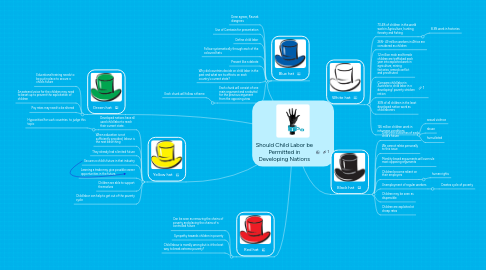Should Child Labor be Permitted in Developing Nations
by Raunak Mascarenhas


1. Blue hat
1.1. Dean agrees, Raunak disagrees
1.2. Use of Camtasia for presentation
1.3. Define child labor
1.4. Follow systematically through each of the coloured hats
1.5. Present like a debate
1.6. Why did countries decide on child labor in the past and what are its effects on each country's current state?
1.7. Each chunk will consist of one main argument and a rebuttal for the previous argument from the opposing view
1.7.1. Each chunk will follow a theme
2. Green hat
2.1. Educational training needs to be put in place to secure a child's future
2.2. An external voice for the children may need to beset up to prevent the exploitation of children
2.3. Pay rates may need to be altered
3. Yellow hat
3.1. Developed nations have all used child labor to reach their current state.
3.1.1. Hypocritical for such countries to judge this topic
3.2. When education is not sufficiently provided, labour is the next best thing
3.3. They already had a limited future
3.4. Secures a child's future in that industry
3.5. Learning a trade may give possible career opportunities in the future.
3.6. Children are able to support themselves
3.7. Child labor can help to get out of the poverty cycle
4. Red hat
4.1. Can be seen as removing the chains of poverty and placing the chains of a controlled future
4.2. Sympathy towards children in poverty
4.3. Child labour is morally wrong but is it the best way to break extreme poverty?
5. White hat
5.1. 70.4% of children in the world work in Agriculture, hunting, forestry and fishing
5.1.1. 8.3% work in factories
5.2. 26%- 49 million workers in Africa are considered as children
5.3. 1.2 million male and female children are trafficked each year into exploited work in agriculture, mining factories, armed conflict and prostituted
5.4. Compare child labor in Australia to child labor in a developing/ poverty stricken nation
5.5. 30% of all children in the least developed nation work as child laborers
5.6. 126 million children work in inhumane conditions
5.6.1. sexual violrnce
5.6.2. abuse
5.6.3. humuiliated
6. Black hat
6.1. Limits the outcomes of each child's future
6.2. We cannot relate personally to this issue
6.3. Morality based arguuments will over rule most opposing arguments
6.4. Children become reliant on their employers
6.4.1. human rights
6.5. Unemployment of regular workers
6.5.1. Creates cycle of poverty
